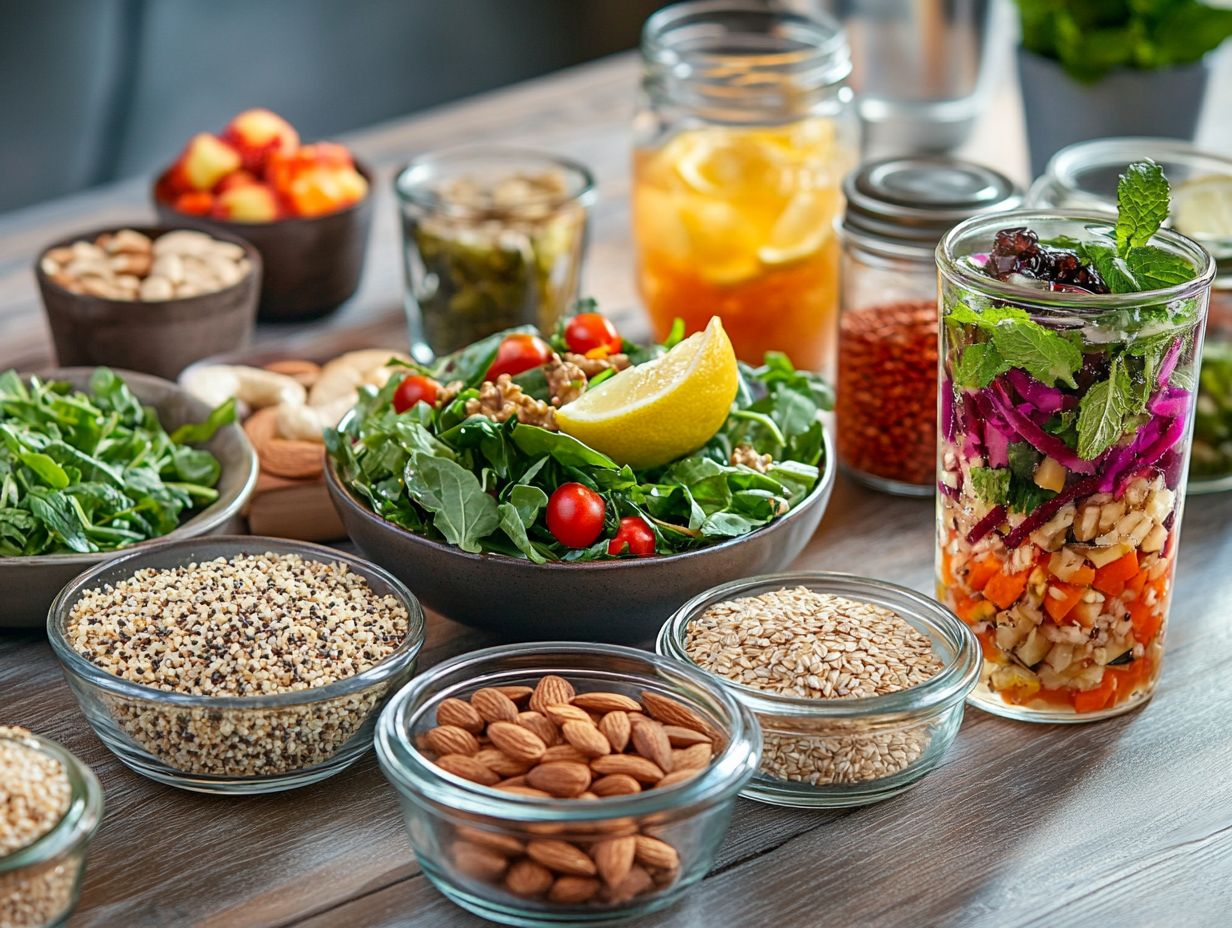5 Easy Swaps for a Healthier Diet
Making small adjustments to your diet can yield remarkable health benefits. Here are five effortless swaps that can enhance your nutrition and foster a healthier lifestyle:
- Choose whole wheat bread instead of white bread.
- Choose fresh fruits instead of processed snacks.
- Replace soda with sparkling water.
- Choose lean protein sources, such as chicken and fish.
You can transform your meals and snacks with ease. Reflect on the advantages these swaps offer for weight management and overall well-being, as well as strategies to maintain these changes over the long haul.
Ready to transform your diet today? Let s explore the possibilities!
Contents
- Key Takeaways:
- 1. Swap White Bread for Whole Wheat Bread
- 2. Replace Soda with Sparkling Water
- 3. Choose Lean Protein Sources
- 4. Opt for Healthy Fats Instead of Unhealthy Ones
- 5. Snack on Fresh Fruits and Vegetables Instead of Processed Snacks
- What Are the Benefits of Making These Dietary Swaps?
- Frequently Asked Questions
- 1. 5 Simple Swaps for a Healthier You!
- 2. How can swapping white bread for whole grain bread improve my diet?
- 3. Why is it important to choose water over sugary drinks?
- 4. What makes brown rice a healthier option than white rice?
- 5. How does using Greek yogurt instead of sour cream benefit my health?
- 6. Can swapping red meat for lean proteins really make a difference?
Key Takeaways:

- Swap out white bread for whole wheat bread to increase fiber intake and improve digestion.
- Replacing soda with sparkling water can reduce sugar and calorie intake, leading to better weight management.
- Choosing lean protein sources, such as chicken and fish, can help decrease saturated fat intake and improve heart health.
1. Swap White Bread for Whole Wheat Bread
Swapping white bread for whole wheat is a straightforward yet powerful adjustment that resonates with healthy eating principles. This simple change provides extra fiber and nutrients that refined grains typically lack, ultimately enhancing your nutrition.
This transition not only elevates your daily fiber intake essential for digestive health but it also plays a crucial role in stabilizing blood sugar levels. Whole wheat is an exceptional choice for anyone monitoring their glucose levels. Unlike refined grains that can cause frustrating spikes and crashes in blood sugar, whole grains release energy more gradually, providing a steadier source of fuel.
Incorporating whole wheat bread into your meals can be enjoyable and effortless. You can prepare hearty sandwiches packed with leafy greens, lean proteins, and healthy fats, or enjoy a slice of toasted whole wheat bread topped with creamy avocado and vibrant cherry tomatoes for a nutritious breakfast that kick-starts your day.
2. Replace Soda with Sparkling Water
You can replace soda with sparkling water to bid farewell to sugar-laden beverages. It offers a refreshing alternative that reduces calories while keeping you hydrated without the burden of added sugars or artificial ingredients.
This straightforward switch can significantly diminish your risk of health issues such as obesity, diabetes, and heart disease, which are often linked to excessive sugar in traditional soft drinks. Sparkling water brings a delightful fizz, enhanced by a variety of flavors that elevate your drinking experience without the negative impact of added sugars.
Many brands now craft sparkling water infused with vitamins, amplifying its health benefits. For a personalized twist, consider infusing your sparkling water with fresh fruits or aromatic herbs; this addition can elevate its flavor even further. This option stands out as a superior choice compared to unsweetened tea, providing a unique and enjoyable way to stay hydrated throughout your day.
3. Choose Lean Protein Sources
Choosing lean protein sources, such as plant-based options and healthier alternatives to processed meats, is essential for maintaining a balanced diet. This decision can lead to improved health outcomes and elevate your overall nutrition.
Incorporating a variety of protein sources provides essential nutrients while introducing diverse flavors and textures to your meals. Lean meats like chicken and turkey support muscle repair, while seafood provides omega-3 fatty acids, a type of healthy fat that supports heart health. On the flip side, legumes like lentils and chickpeas are fiber-rich, promoting digestive wellness and sustained energy.
Plant-based proteins, including quinoa and beans, are versatile and packed with vitamins and minerals. If you’re looking to diversify your meals, consider simple recipes like a quinoa salad with black beans or baked salmon with steamed vegetables both effortless ways to highlight these nutritious options.
4. Opt for Healthy Fats Instead of Unhealthy Ones

Choosing healthy fats over unhealthy ones can supercharge your diet! Incorporating omega-3s from fish or flaxseeds enhances your meals and supports lifestyle changes leading to better health.
By opting for healthier choices, you can boost your cardiovascular health and enhance brain function. Healthy fats from sources like avocados, nuts, and olive oil add delicious flavor and improve the absorption of fat-soluble vitamins, which are vitamins that dissolve in fats and oils.
Imagine a fresh salad drizzled with extra virgin olive oil. It transforms a simple dish into a nutrient powerhouse. Snacks like dark chocolate, rich in cocoa, are a satisfying treat that delivers a punch of powerful antioxidants.
For cooking, consider methods like baking, where you can swap butter for olive oil, or saut ing vegetables with a splash of coconut oil. This way, you can easily weave these beneficial fats into your daily meals.
5. Snack on Fresh Fruits and Vegetables Instead of Processed Snacks
Opting for fresh fruits and vegetables instead of processed snacks satisfies cravings and enhances your overall health. These vibrant choices provide essential nutrients while keeping unhealthy ingredients at bay, promoting healthier eating habits.
Incorporating options like crisp carrots, refreshing cucumber slices, and a handful of berries can elevate your energy levels and deliver vital vitamins and minerals. These natural snacks are abundant in fiber, supporting digestion and helping you maintain a healthy weight.
If you’re seeking variety, prepare a colorful salad brimming with leafy greens or blend a nutrient-packed smoothie. Both are delightful and fulfilling!
On the flip side, indulging in sugary, processed snacks often results in energy crashes and offers minimal nutritional value. Choosing fresh produce is a superior strategy for your well-being. Make the switch today and feel the difference!
What Are the Benefits of Making These Dietary Swaps?
Making dietary swaps, like choosing whole grains over refined grains or opting for unsweetened beverages instead of sugary ones, significantly enhances your overall health. These changes support weight management and cultivate a culture of healthy eating and informed nutrition.
Incorporating these alternatives leads to improved digestion, as whole grains are packed with fiber that promotes regularity and supports gut health. Experts, including Laurie Herr, emphasize that reducing processed sugars lowers the risk of chronic diseases like heart disease and diabetes, a crucial decision for anyone seeking to improve their long-term well-being.
By choosing nutritious options, you can effectively manage your weight, as whole foods generally contain fewer calories and more essential nutrients. The Dietary Guidelines for Americans advocate for these swaps, highlighting their vital role in promoting a healthier lifestyle for individuals of all ages.
How Can These Swaps Help with Weight Management?
These dietary swaps can be a game-changer for weight management, helping to cut down on calories while encouraging healthier eating habits and appropriate portion sizes that lead to sustainable weight loss and maintenance.
Research shows that when individuals replace higher-calorie ingredients with lower-calorie options, they often achieve noticeable weight loss. For instance, a simple switch from white bread to whole grain can save you up to 300 calories a day.
To make these changes, start by gradually adding more fruits and vegetables to your meals aim for half your plate to be filled with these nutritious options. Choosing healthier snacks, like air-popped popcorn instead of chips or yogurt in place of ice cream, satisfies cravings while keeping caloric intake in check.
Keeping a food diary can reveal insights into your eating patterns, helping you align your portion sizes with your personal nutrition goals.
What Are the Nutritional Differences Between These Swaps?

Understanding the nutritional differences between dietary swaps, like refined grains versus whole grains, is essential for making informed choices. This knowledge about nutrition elevates your healthy eating practices and enhances your overall well-being.
Whole grains, unlike their refined counterparts, retain the nutritious parts of the grain, which include the bran and germ. These components are treasure troves of fiber, B vitamins, and vital minerals like iron and magnesium. Retaining these nutrients boosts your digestive health and regulates blood sugar levels.
For example, make the switch now from white rice to quinoa or brown rice. This not only increases the nutrient content but also introduces a delightful nuttiness and chewy texture to your meals.
Similarly, swapping white bread for whole grain alternatives enriches your meals with added fiber. This helps you feel fuller and encourages better portion control.
How Can These Swaps Improve Overall Health?
These dietary swaps enhance your overall health and inspire lifestyle changes that deepen your understanding of nutrition. Ultimately, this leads to long-term benefits for both your physical and mental well-being.
By choosing whole grains over refined grains, you significantly reduce your risk of chronic diseases such as heart disease and diabetes. The World Health Organization emphasizes the importance of incorporating fruits and vegetables into your daily meals. They provide essential nutrients that bolster a robust immune system.
Research has shown that better nutrition is linked to improved mental health. Whole, unprocessed foods positively influence your mood and cognitive function. These thoughtful adjustments nourish your body and foster a more balanced mindset.
What Are Some Other Simple Swaps for a Healthier Diet?
In addition to the swaps you’ve already explored, consider these other simple tweaks and healthier alternatives:
- Replace traditional pasta with spiralized vegetables like zucchini or carrots. This cuts down on carbohydrates while elevating your fiber intake.
- Make your own salad dressings using olive oil and vinegar instead of store-bought options packed with preservatives.
- Substitute mayonnaise with Greek yogurt for that desirable creaminess without the added calories and fat.
- Incorporate more legumes, such as lentils and chickpeas, into your meals. This boosts your protein levels while decreasing your dependence on meat.
These modest changes can profoundly enrich your daily nutrition and pave the way for a healthier lifestyle.
How Can One Stick to These Swaps in the Long Run?
Sticking to these dietary swaps over the long haul demands a genuine commitment to lifestyle changes. It’s important to understand healthy eating practices and consciously monitor portion sizes while savoring nutritious foods.
To maintain these changes effectively, cultivate a meal prepping routine. By dedicating time each week to prepare wholesome meals and snacks, you can significantly reduce the temptation to fall back on less nutritious options when hunger strikes.
Keeping a food journal helps you track your intake and identify patterns, making it easier to hold yourself accountable. Engaging with a supportive community can greatly enhance your journey.
Resources like Change4Life and EatingWell provide invaluable tips, recipes, and forums that foster connections. This encourages ongoing motivation and shared experiences for those navigating similar challenges.
Frequently Asked Questions

1. 5 Simple Swaps for a Healthier You!
Try these simple swaps for a healthier diet! Replace white bread with whole grain bread, and choose water over sugary drinks.
Switch to brown rice instead of white, use Greek yogurt in place of sour cream, and opt for lean proteins like chicken or fish instead of red meat.
2. How can swapping white bread for whole grain bread improve my diet?
Whole grain bread is packed with fiber. This helps you feel full longer and supports digestion.
It also offers more nutrients, including B vitamins and iron, compared to white bread.
3. Why is it important to choose water over sugary drinks?
Sugary drinks like soda and juice are high in calories and sugar, which can lead to weight gain and increase the risk of health issues like diabetes.
Water, meanwhile, is calorie-free and essential for staying hydrated.
4. What makes brown rice a healthier option than white rice?
Brown rice is a whole grain, meaning it has all parts of the grain intact. This results in higher fiber and more nutrients.
It also has a lower glycemic index, meaning it has a slower effect on blood sugar levels, helping keep your blood sugar steady.
5. How does using Greek yogurt instead of sour cream benefit my health?
Using Greek yogurt instead of sour cream offers health benefits. It is lower in calories and saturated fat.
Greek yogurt contains beneficial probiotics and is a fantastic source of protein.
6. Can swapping red meat for lean proteins really make a difference?
Yes! Make the switch today and feel the amazing difference in your health.
Opting for lean proteins like chicken or fish can significantly improve your diet. Red meat typically has higher saturated fat and cholesterol, while lean proteins are lower in fat and often contain more essential nutrients.






